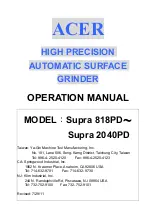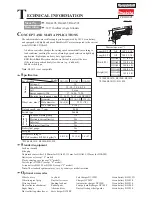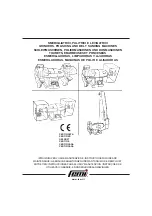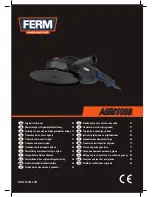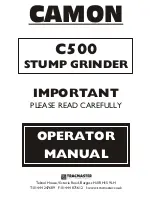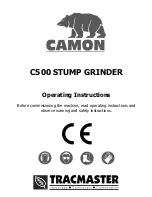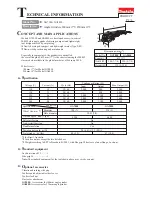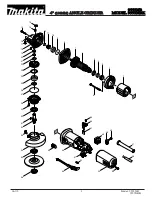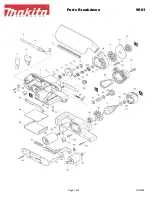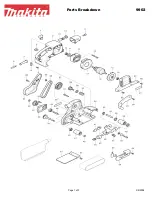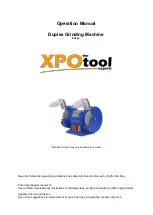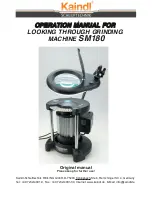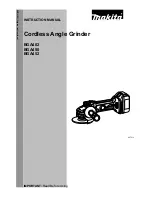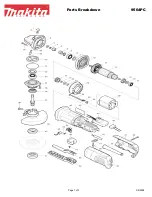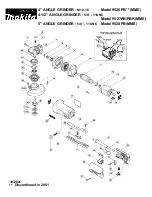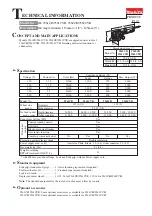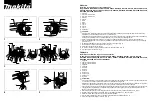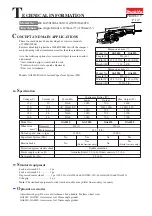
4.
Afloje y quite la tuerca de sujeción
del vástago. NO quite el reborde del
disco.
5.
Coloque la rueda accesoria sobre
el
vástago.
Instale
siempre
la rueda abrasiva y el disco de paño
abrasivo con el centro rebajado contra
el reborde del disco como se muestra
anteriormente. De lo contrario hará que
la rueda abrasiva se quiebre cuando
ajuste la tuerca de sujeción. Esto puede
resultar en lesiones personales graves
ya que las partículas flojas pueden
desprenderse y
ser lanzadas desde la
rectificadora. No
apriete en exceso.
6.
Para instalar la rueda abrasiva
y
e
l
cepillo circular de alambre:
enrosque la tuerca de sujeción en
el
vástago con el lado plano de la
tuerca hacia arriba. Calce la parte
elevada, de diámetro pequeño de
la
tuerca de sujeción en el orificio
de la rueda y ajústela con la mano.
7.
Para instalar el disco de paño
abrasivo: enrosque la tuerca de
sujeción en el vástago con el lado
Asegúrese de instalar la protección de
la rueda y el mango auxiliar. Tome con
firmeza el mango auxiliar y la caja del
motor.
Levante la parte trasera de la caja del
motor para que sólo la sección frontal
de la rueda abrasiva entre en contacto
con el trabajo. Aplique poca presión.
La
rectificadora siempre debe estar
alejada del trabajo antes de encender
o
detener el motor. La flecha en la caja
de engranajes frontal indica la dirección
en la que gira la rueda abrasiva.
La
flecha se parece al número 1.
RECTIFICADO, LIJADO, CEPILLADO
Siempre seleccione con cuidado y use
ruedas abrasivas recomendadas para el
material a rectificar. Asegúrese de que la
velocidad mínima de funcionamiento de
las ruedas accesorias seleccionadas no sea
menor que 11.000 RPM.
La rueda abrasiva que se proporciona con
su rectificadora es apta para rectificar
soldaduras, preparar superficies para
soldar, y rectificar acero estructural y
acero inoxidable. El cepillo circular de
alambre es adecuado para eliminar
pintura u óxido de las superficies de
metal. El disco de paño abrasivo es
adecuado para lijar superficies planas
de
metal o madera.
Nunca
use la
rectificadora sin la protección. Esta
herramienta fue diseñada para ser
usada ÚNICAMENTE con la protección
instalada. De intentar usar la
rectificadora sin la protección, se
podrán desprender partículas que sean
arrojadas contra el operador, resultando
en lesiones personales graves.
Inspeccione el cepillo circular de
alambre antes de cada uso. Nunca use
un cepillo oxidado, dañado o cuya
velocidad nominal mínima no sea de
10.000 RPM o superior. No seguir esta
advertencia puede resultar en lesiones
personales graves.
La clave para un funcionamiento
eficiente comienza controlando la
presión y el contacto con la superficie
entre la rueda abrasiva y la pieza de
trabajo. Las superficies planas se
rectifican a un ángulo agudo,
normalmente entre 5 y 15 grados
(ver
Figura 5).
Para un máximo control, sostenga la
rectificadora con ambas manos, de
frente y lejos de usted, manteniendo
la
rueda abrasiva fuera de la pieza de
trabajo. Encienda la rectificadora y
deje que el motor y la rueda abrasiva
plano de la tuerca hacia abajo.
Ajuste con la mano (vea la figura 4).
8.
Oprima el botón del bloqueo del
vástago y gire la rueda hacia la
derecha hasta que el vástago se
tranque en la posición.
9.
Ajuste la tuerca de sujeción de
modo seguro con la llave que se
proporciona. No apriete en exceso.
Las
cerdas
del cepillo circular de alambre se
doblarán durante el uso y
mostrarán su
dirección de rotación. Cuando vuelva a
usar el cepillo circular de alambre,
móntelo siempre en la misma dirección
que el uso anterior. De
no seguir esta
advertencia, las cerdas se podrán
romper y la vibración extrema del
cepillo circular de alambre podría
ocasionar lesiones personales graves.
Funcionamiento
INTERRUPTOR DE CORRIENTE
El interruptor de corriente se bloquea en
la posición ON empujando
completamente el interruptor hacia
adelante y luego empujando la porción
anterior del interruptor hacia abajo.
Para
apagar la herramienta (OFF),
presione hacia abajo la porción posterior
del interruptor eléctrico.
Se deberán usar gafas de
seguridad durante el
funcionamiento.
Asegúrese de que el trabajo esté sujeto
en forma segura en una prensa de
tornillo o mordaza antes de comenzar
la operación. Si la pieza de trabajo está
floja puede girar y causar lesiones
corporales.
25
Sp
DG470500CK
General Power T
ool
Safety W
a
rnings
(Continued)
1.
Do not use accessories which are
not specifically designed and
recommended by the tool
manufacturer. Just because the
accessory can be attached to your
power tool, it does not assure safe
operation.
2.
The rated speed of the accessory
must be at least equal to the
maximum speed marked on the
power tool. Accessories running
faster than their rated speed can fly
apart.
3.
The outside diameter and the
thickness of your accessory must be
within the capacity rating of your
power tool. Incorrectly sized
accessories cannot be adequately
guarded or controlled.
4.
The arbour size of wheels, flanges,
backing pads or any other accessory
must properly fit the spindle of the
power tool. Accessories with arbour
holes that do not match the
mounting hardware of the power
tool will run out of balance, vibrate
excessively and may cause loss of
control.
5.
Do not use a damaged accessory.
Before each use inspect the
accessory for chips and cracks,
backing pad for cracks, tear or
excess wear, wire brush for loose or
cracked wires. If power tool or
accessory is dropped, inspect for
damage or install an undamaged
accessory. After inspecting and
installing an accessory, position
yourself and bystanders away from
the plane of the rotating accessory
and run the power tool at
maximum no load speed for one
minute. Damaged accessories will
normally break apart during this
test time.
6.
Keep bystanders a safe distance
away from work area. Anyone
entering the work area must wear
personal protective equipment.
Fragments of workpiece or of a
broken accessory may fly away and
cause injury beyond immediate area
of operation.
7.
Hold power tool by insulated
gripping surfaces only, when
performing an operation where the
cutting accessory may contact
hidden wiring or its own cord.
Cutting accessory contacting a
"live" wire may make exposed
metal parts of the power tool "live"
and shock the operator.
8.
Position the cord clear of the
spinning accessory. If you lose
control, the cord may be cut or
snagged and your hand or arm may
be pulled into the spinning
accessory.
9.
Never lay the power tool down
until the accessory has come to a
complete stop. The spinning
accessory may grab the surface and
pull the power tool out of your
control.
10.
Do not run the power tool while
carrying it at your side. Accidental
contact with the spinning accessory
could snag your clothing, pulling
the accessory into your body.
11.
Regularly clean the power tool’s air
vents. The motor’s fan will draw the
dust inside the housing and
excessive accumulation of
powdered metal may cause
electrical hazards.
12. This tool must NOT be modified or
used for any application other than
that for which it was designed.
1
3
.Maintain tools with care.
14.
Always hold the grinder securely
with two hands while working and
at all times when it is running.
15.
Never cover the air vents in the
motor housing with your hands
while operating the grinder.
16.
Hold the tool away from your body
while it is running. Keep your hands
away from the attachments.
PRECAUTIONS: SANDING PAINT
Sanding of lead based paint is NOT
RECOMMENDED due to the difficulty
of controlling the contaminated dust.
The greatest danger of lead poisoning
is to children and pregnant women.
Since it is difficult to identify whether
or not a paint contains lead without a
chemical analysis, we recommend the
following precautions when sanding
any paint:
A. PERSONAL SAFETY
1.
No children or pregnant women
should enter the work area where
the paint sanding is being done
until all clean up is completed.
2.
A dust mask or respirator should be
worn by all persons entering the
work area. The filter should be
replaced daily or whenever the
wearer has difficulty breathing.
Note:
Only those dust masks suitable
for working with lead paint dust and
fumes should be used. Ordinary
painting masks do not offer this
protection. See your local hardware
dealer for the proper (NIOSH approved)
mask.
3.
NO EATING, DRINKING or SMOKING
should be done in the work area to
prevent ingesting contaminated
paint particles. Workers should
wash and clean up BEFORE eating,
drinking or smoking. Articles of
food, drink, or smoking should not
be left in the work area where dust
would settle on them.
B. ENVIRONMENTAL SAFETY
1.
Paint should be removed in such a
manner as to minimize the amount
of dust generated.
2.
Areas where paint removal is
occurring should be sealed with
plastic sheeting of 4 mils thickness.
3.
Sanding should be done in a
manner to reduce tracking of paint
dust outside the work area.
C. CLEANING AND DISPOSAL
1.
All surfaces in the work area should
be vacuumed and thoroughly
cleaned daily for the duration of
the sanding project. Vacuum filter
bags should be changed frequently.
2.
Plastic drop cloths should be
gathered up and disposed of along
with any dust chips or other
removal debris. They should be
placed in sealed refuse receptacles
and disposed of through regular
trash pick-up procedures. During
clean up, children and pregnant
women should be kept away from
the immediate work area.
3.
All toys, washable furniture and
utensils used by children should be
washed thoroughly before being
used again.
SERVICE
Have
your
power tool serviced by a qualified
repair person using only identical
replacement parts. This will ensure that
the safety of the power tool is main-
tained.
Further Safety
Instructions For All
Operations
Kickback And Related
W
a
rnings
Kickback is a sudden reaction to a
pinched or snagged rotating wheel,
backing pad, brush or any other
accessory. Pinching or snagging causes
rapid stalling of the rotating accessory
which in turn causes the uncontrolled
4
www.chpower.com
Operating Instructions and Parts Manual
Tuerca de sujeción
enroscada de modo
incorrecto
Cepillo
circular de
alambre
Tuerca de
sujeción
enroscada
de modo
correcto
Rueda
abrasiva
Reborde
del disco
Tuerca
de
sujeción
Vástago
Llave
Para
ajustar
Para
aflojar
Protección
Figura 2
Figura 3
Tuerca de sujeción
enroscada de modo
incorrecto
Disco de
paño
abrasivo
Tuerca de
sujeción
enroscada
de modo
correcto
Figura 4















